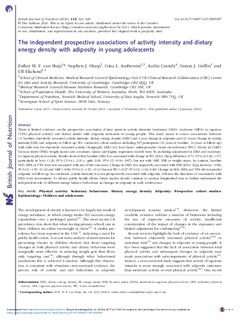| dc.contributor.author | van Sluijs, Esther M. F. | |
| dc.contributor.author | Sharp, Stephen J. | |
| dc.contributor.author | Ambrosini, Gina L. | |
| dc.contributor.author | Cassidy, Aedin | |
| dc.contributor.author | Griffin, Simon J. | |
| dc.contributor.author | Ekelund, Ulf | |
| dc.date.accessioned | 2017-03-20T13:34:14Z | |
| dc.date.available | 2017-03-20T13:34:14Z | |
| dc.date.issued | 2016-01-13 | |
| dc.identifier.citation | British Journal of Nutrition. 2016, 115, 921-929 | nb_NO |
| dc.identifier.uri | http://hdl.handle.net/11250/2434732 | |
| dc.description.abstract | There is limited evidence on the prospective association of time spent in activity intensity (sedentary (SED), moderate (MPA) or vigorous (VPA) physical activity) and dietary intake with adiposity indicators in young people. This study aimed to assess associations between (1) baseline objectively measured activity intensity, dietary energy density (DED) and 4-year change in adiposity and (2) 4-year change in activity intensity/DED and adiposity at follow-up. We conducted cohort analyses including 367 participants (10 years at baseline, 14 years at follow-up) with valid data for objectively measured activity (Actigraph), DED (4-d food diary), anthropometry (waist circumference (WC), %body fat (%BF), fat mass index (FMI), weight status) and covariates. Linear and logistic regression models were fit, including adjustment for DED and moderate-to-vigorous physical activity. Results showed that baseline DED was associated with change in WC (β for 1kJ/g difference: 0·71; 95% CI 0·26, 1·17), particularly in boys (1·26; 95% CI 0·41, 2·16 v. girls: 0·26; 95% CI −0·34, 0·87), but not with %BF, FMI or weight status. In contrast, baseline SED, MPA or VPA were not associated with any of the outcomes. Change in DED was negatively associated with FMI (β for 1kJ/g increase: −0·86; 95% CI −1·59, −0·12) and %BF (−0·86; 95% CI −1·25, −0·11) but not WC (−0·27; 95% CI −1·02, 0·48). Change in SED, MPA and VPA did not predict adiposity at follow-up. In conclusion, activity intensity was not prospectively associated with adiposity, whereas the directions of associations with DED were inconsistent. To inform public health efforts, future studies should continue to analyse longitudinal data to further understand the independent role of different energy-balance behaviours in changes in adiposity in early adolescence. | nb_NO |
| dc.language.iso | eng | nb_NO |
| dc.publisher | Cambridge University Press | nb_NO |
| dc.subject | physical activity | nb_NO |
| dc.subject | sedentary behaviours | nb_NO |
| dc.subject | dietary energy density | nb_NO |
| dc.subject | adiposity | nb_NO |
| dc.subject | prospective cohort studies | nb_NO |
| dc.subject | epidemiology | nb_NO |
| dc.subject | children and adolescents | nb_NO |
| dc.title | The independent prospective associations of activity intensity and dietary energy density with adiposity in young adolescents | nb_NO |
| dc.type | Journal article | nb_NO |
| dc.type | Peer reviewed | nb_NO |
| dc.subject.nsi | VDP::Matematikk og Naturvitenskap: 400::Basale biofag: 470 | nb_NO |
| dc.subject.nsi | VDP::Medisinske Fag: 700::Basale medisinske, odontologiske og veterinærmedisinske fag: 710 | nb_NO |
| dc.subject.nsi | VDP::Medisinske Fag: 700::Klinisk medisinske fag: 750 | nb_NO |
| dc.subject.nsi | VDP::Medisinske Fag: 700::Helsefag: 800 | nb_NO |
| dc.source.journal | British Journal of Nutrition | nb_NO |
| dc.identifier.doi | 10.1017/S0007114515005097 | |
| dc.description.localcode | Seksjon for idrettsmedisinske fag / Department of Sports Medicine | nb_NO |
